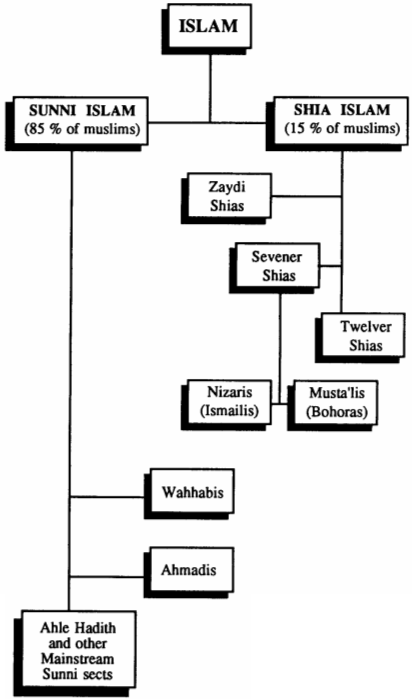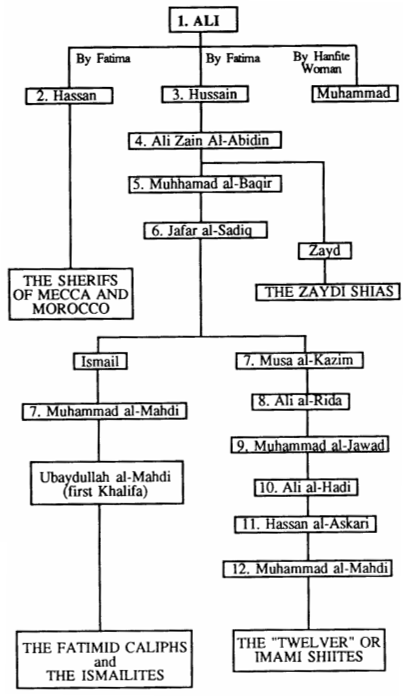Like other religions in the world, Islam has its share of religious dissension and sects. At numerous times during the course of Islamic history, political events and ideological and theological issues divided the Muslim community into various groups which then started to identify with specific causes. At present there are more than 73 sects in Islam.
Basically, there are two main divisions in Islam: the Sunnis and the Shias. All other sects developed from these two main streams. To give an idea of their relative proportions, about 85% of all “Muslims” living today belong to the Sunni stream of Islam while about 15% belong to the Shia stream. Some important sects of Islam and their relationship with the two main streams are shown below:
Sunni Stream of Islam:
Ahle Hadith (Traditionists)
- Wahhabis
- Ahmadis
Shia Stream of Islam:
- Zaydis
- Twelvers
- Seveners: Nizaris or Ismailis; Musta’lis or Bohrahs
The Development of Sects in Islam

The Sunni Muslims
As mentioned above, the main body of Muslims comprises the Sunnis who accept the authority and the bona fide status of the first four “Pious” Khalifahs and the comprehensive system of Islamic law, the Shari’a. There are four distinct orthodox law schools recognised by the Sunnis. These are: the Malikis, Hanafis, Shafi’ees and Hanbalis. These schools are based on the interpretation of Islamic law by the four well known Islamic jurists and theologians of the first three centuries of Islam: Imam Malik bin Anas, Imam Abu Hanifa, Imam Muhammad bin Idris al-Shafi and Imam Ahmad bin Hanbal. Although the founders of the four schools of law differ significantly on many matters related to the regulations of worship and the law, there is a certain cohesion within the Sunni community which allows this variance to exist without destroying the fundamental unity of beliefs in this stream of Islam.
A majority of the Sunni Muslims belong to the Ahle Hadith or Traditionist sect. They give particular importance to the sayings and doings of the Holy Prophet, as recorded in the various books of Hadith. Over the years, many sects developed which took issues from some of the main beliefs of the Traditionists. Of these sects we will discuss only two, the Wahhabis and the Ahmadis.
The Wahhabis
The Wahhabi sect rose in the middle of the eighteenth century within the Arabian Peninsula. The Wahhabi movement was started by Muhammad bin Abdul Wahhab (1703-1793 AD) who was a native of Najd, a province in north-central Arabia. He preached a strict puritanical Islam which forbade the veneration of holy places, religious relics and holy men. Amir Muhammad ibn Sa’ud of Dar’iyyah accepted Wahhabi beliefs and his descendants, the House of Sa’ud, did much to propagate and establish Wahhabi doctrines in Arabia and surrounding area. During the spread of the political influence of the House of Sa’ud, numerous armed conflicts occurred with the Ottoman Empire of Turkey.
The Ahmadis
 The Ahmadiyya movement was founded in 1889 as a sect of Islam by Hadhrat Mirza Ghulam Ahmad, may peace be upon him, of Qadian, India. Hadhrat Mirza Ghulam Ahmad claimed to be the Mujaddid (reformer) of the fourteenth century of Islam and the Promised Messiah and the Promised Mahdi whose advent had been foretold in the Hadith of the Holy Prophet Muhammad, may peace and blessings be upon him. The Ahmadis generally follow the Hanafi school of law.
The Ahmadiyya movement was founded in 1889 as a sect of Islam by Hadhrat Mirza Ghulam Ahmad, may peace be upon him, of Qadian, India. Hadhrat Mirza Ghulam Ahmad claimed to be the Mujaddid (reformer) of the fourteenth century of Islam and the Promised Messiah and the Promised Mahdi whose advent had been foretold in the Hadith of the Holy Prophet Muhammad, may peace and blessings be upon him. The Ahmadis generally follow the Hanafi school of law.
As far as the fundamental beliefs or acts of worship are concerned, the Ahmadi Muslims have neither taken anything out nor added anything new to the religion of Islam. The Ahmadi Muslims make their declaration of faith by reciting the same kalima which was recited by the Holy Prophet Muhammad, may peace and blessings be upon him, himself; they say their Prayers and Fast in the same manner as the Holy Prophet Muhammad, may peace and blessings be upon him, did; and their Qiblah, their Ka’aba, their Adhan and their Qur’an are all exactly the same as Sunni Muslims. There are basically three beliefs held by Ahmadi Muslims which separate them from the mainstream of Sunni Islam. These three beliefs concern:
- The finality of Muhammad’s Prophethood.
- Jesus Christ’s ascension to heaven.
- The identity of the Promised Messiah
The Shia Muslims
The Shia stream of Islam traces its origins in political developments dating back to the period of Hazrat Uthman, the third (Khalifah) successor of the Holy Prophet. After the death of Hazrat Umar, the second Khalifah, a council of six persons was entrusted with the task of electing the new Khalifah. The backers and supporters of Hadhrat Ali, the fourth Khalifah, showed visible disappointment at the outcome and called the election a “conspiracy” to withhold the Khilafat from the Prophet’s own family (Hadhrat Ali was the Prophet’s cousin). This was the first seed of dissension which appeared in Islam and eventually divided the otherwise united community.
During the reign of the Umayyad Khalifahs, the supporters of the House of Ali led many unsuccessful religious revolts. They never recognised the authority of the Umayyad Khalifahs and followed their own Imams who were the direct descendents of Hadhrat Ali. The Shias eventually split into many sects, five of which are noteworthy.
The Twelver Shias or Asna-ashariya
 These comprise the largest group of the Shias today and exhibit most of the classical Shia doctrines. The Twelver Shias are known by this name because they follow the twelve Imams, all belonging to the House of Ali. Their twelfth Imam, Muhammad al-Mahdi, is believed by them to be still alive and in hiding. The Shias believe in the Messianic return of this Imam in the latter days of Islam.
These comprise the largest group of the Shias today and exhibit most of the classical Shia doctrines. The Twelver Shias are known by this name because they follow the twelve Imams, all belonging to the House of Ali. Their twelfth Imam, Muhammad al-Mahdi, is believed by them to be still alive and in hiding. The Shias believe in the Messianic return of this Imam in the latter days of Islam.
According to the Shia’s belief, Hadhrat Ali inherited all the spiritual abilities of the Holy Prophet and was thus the only rightful successor of his. The Shias, therefore, reject the Khilafats of Hadhrat Abu Bakr, Hadhrat Umar and Hadhrat Uthman and that of the Umayyad dynasty that followed.
The Shia’s do not accept many Ahadith of the Holy Prophet which were transmitted by Hadhrat A’isha, the wife of the Holy Prophet, whom they consider an enemy of Islam. The Shias also differ from the Sunni Muslims in many other areas such as the regulations governing the ablution, Adhan, Prayer, Pilgrimage and the declaring of one’s faith.
The Shias also retain the pre-Islamic custom of legal temporary marriage for the sake of pleasure, called mut’ah. Today, the Twelver Shias are predominant in Iran. Outside Iran, there are large Shia communities in Iraq, Pakistan, India and Lebanon.
The Sevener Shias
The division of the Shias into the Twelver and the Sevener sects occurred after their sixth Imam, Jafar al-Sadiq. At the death of Jafar al-Sadiq in 765 AD, the Twelvers made his younger brother, Musa al-Kazim, their seventh Imam. A dissenting group, later called the Seveners, followed the line of Jafar al-Sadiq’s direct descendents. Since Jafar al-Sadiq’s own son, Ismail, had predeceased him, the Seveners recognised the new Imam in the son of Ismail named Muhammad al-Mahdi. For this reason the Sevener Shias are also referred to as the Ismailis.
After the death of the Fatimid Khalifah al-Mustansir in 1095 AD, the Ismailis divided into two sects. The ones who followed the younger son of al-Mustansir by the name of al-Musta’li who became the next Khalifah, are called Musta’lis. The others who followed the elder son by the name of al-Nisar who was imprisoned, are called Nizaris.
The Nizari Ismailis
The Nizaris took their leader al-Nisar into a mountain fortress and for a number of years led a life of secrecy and terror. They were notorious for carrying out well planned assassinations of their enemies and opponents. In 1817AD, one Nazari Ismaili Imam was given the title of Agha Khan by Qajar Shah of Iran. This Imam later moved to India where his da’is or missionaries had considerable success in converting the local Hindu population to their doctrines. Since then the title of Agha Khan has been retained by the Nazari Ismailis for their Imams.
The Musta’li Bohras
The Musta’lis continued to follow the direct line of al-Musta’li. But the visible line of Musta’li Imams ended in 1130 AD when al-Musta’li’s son, al-Amir, died leaving only an infant son by the name of al-Tayyeb. The Fatimid Caliphate continued through the new Khalifah al-Hafiz who was the grandson of al-Mustansir. But since al-Hafiz and the other Khalifahs that followed him were not in direct line of descent from al-Musta’li, the Musta’li Shias did not recognise them as their Imams.
According to the Musta’li belief, the infant son of al-Amir is in hiding and is considered by them as the invisible Imam. The Musta’lis of Yemen managed to convert large numbers of Hindus in Gujrat, a province in western India. These converts are known in India and Pakistan as Bohras.
THE HOUSE OF ALI
The various imams of Shiites and Ismailis are indicated by number


